Behind the Bow
Wildcat Archery’s tight-knit community aims for personal and athletic excellence.
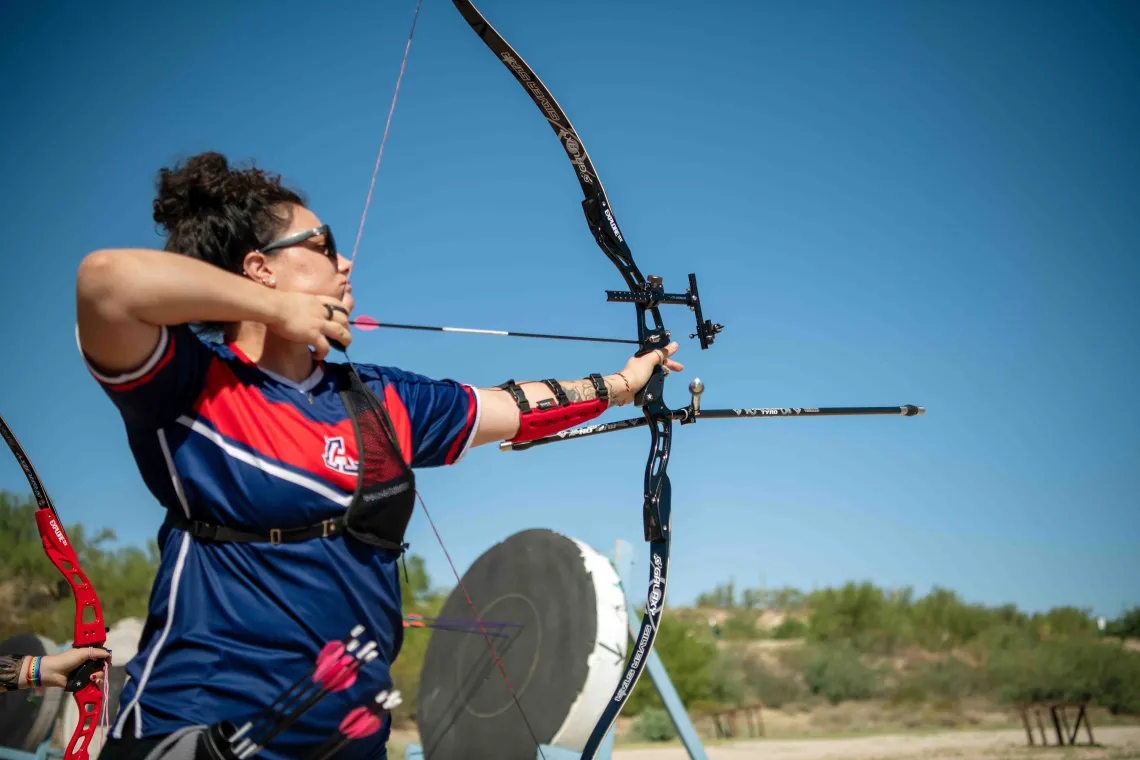
Focused and determined, archer Caitlin Brady draws her bow, aiming for the target.
Photos: Cory Aaland
With feet planted on the ground, shoulders in line with the target, and muscles paired to the bow, the archer prepares to shoot. Tension builds as they inhale, focus their eyes, and tighten their back muscles.
Three ... two ... one. The archer exhales, and their fingers release the string. The arrow hisses through the air, its tip piercing the target with a muffled thud.
While most students may use Sundays to catch up on sleep or recover from a busy week, members of the University of Arizona Wildcat Archery team hit the range by 9 a.m. to perfect their bowmanship.
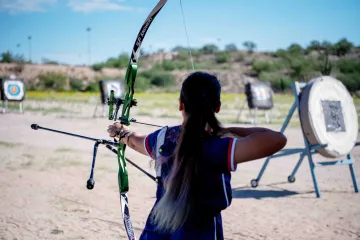
Caitlin Wong received Outstanding Sportsperson of the Year recognition from Campus Recreation.
The club welcomes all styles of archery, including both the classic recurve and the compound bow, as well as archers interested in both competitive and recreational archery.
Wildcat Archery had an established competitive team prior to the coronavirus pandemic. Once the pandemic struck, the club went into “hibernation,” says Caitlin Wong, a computer science major.
In 2021, Wong and former member Maya Boyle ’22 came together determined to restore the organization.
“We had to pick up the pieces and build everything together. Slowly but surely, we grew from five archers to 20-plus at each practice,” Wong says.
The team found support in local duo Terry and Diana LaBeau. The coaching couple organized logistics, collected equipment donations and offered their experience as seasoned archers.
“A lot of newbies are here,” Terry LaBeau says with a proud smile. “Really makes you feel good that we keep growing.”
In 2022, Wong received Outstanding Sportsperson of the Year recognition from Campus Recreation for her exceptional coordination efforts and personal achievements as a competitor.
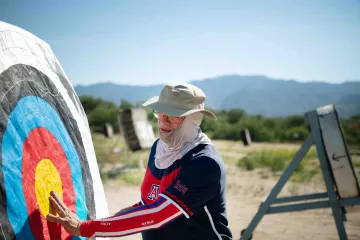
Coach Lawrence Brady examines the target, touching the bull's-eye.
Wong first picked up a bow in ninth grade after stumbling across an archery booth at a gun show. After a reluctant start, she fell in love with competing. She has since participated in high-level competitions such as the Arizona Cup and SoCal Showdown. She hasn’t entered the Olympic trials yet, but she’s training for the future possibility. Archers at that level typically pull around 35 pounds in weight, sending arrows across distances equivalent to three-quarters of a football field.
The competition team has witnessed many of its students advance post-graduation. This past summer, for example, Elek Miller ’23 was selected to represent Team USA in the World University Games in Chengdu, China.
According to LaBeau, the state of Arizona has some of the highest numbers of registered archers in the United States, with over 1,000 archers affiliated with USA Archery.
Hawaiian Natalianna Ferrara was primarily interested in attending UArizona because of the active scene. Ferrara, currently ranked 10th in the nation for collegiate archery, says she was introduced to the sport through the popular characters Katniss Everdeen in “The Hunger Games” and Merida in Disney’s “Brave.” Her participation in competitive archery, she says, affects her approach to her studies, strengthening not only her physical endurance but also her mental endurance.
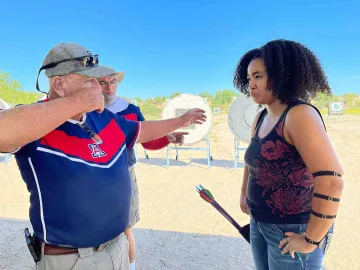
Coaches Darrell Terrsey and Lawrence Brady guide archer Valentina Ayala.
“I can get up there, shoot this arrow and have confidence,” Ferrara says. “That translated to every other aspect of my life. I can take a test and I’m like, ‘OK, I know what I'm doing. I’m not afraid anymore.’”
When students aren’t shooting arrows at practice, they can be found on the benches talking, laughing and engaging in teambuilding exercises.
Coaches and officers coordinate events aimed at uniting teammates and helping students polish their technique. At the end of the year, the team hosts its T-Shirt Painting Practice, where students aim at paint-filled balloons, creating one-of-a-kind pieces. In another tradition, called Suit Shoots, archers practice while dressed to the nines.
For first-time archer Brynn Atonna, it was the organization’s friendly and inclusive environment that encouraged their pursuit of archery even after a rocky start.
“I showed up to my first practice and accidentally shot at the ground,” Atonna says.
Despite the mishap, they decided to come back to the next practice, thanks to the welcoming attitude of the team members. “With me being a beginner, I had never even touched a bow. I had so many people coming to fix my form or tell me what I was doing wrong. And I really appreciated that, ” they say.
Atonna, who now serves as co-president, wants people to know that archery is not exclusive to hunters or a particular type of person. “We let anyone and everyone participate,” Atonna says.
“We always want this to be a welcoming environment.”
Linguistics major Sydney Greenspun echoes the statement, emphasizing that the club’s goal is for students to gain more than just “picking up a bow.” The most rewarding aspect of being part of the team, Greenspun says, is connecting with students from diverse experiences and majors.
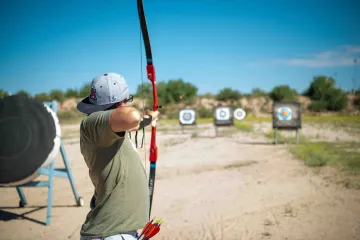
Dylan Coles
“I have a disability,” Greenspun says. “I was always told I couldn’t do sports because I have a prosthetic. This was the last thing I thought I’d be doing in college — being on a sports team.”
The main barrier collegiate archers face is financial. While recreational shooters might invest $200 for their own equipment, competitive teammates spend much more for equipment and travel. Ferrara estimates that she has paid $4,000 to $5,000 throughout her competitive career.
“A lot of our team is financially independent of their families,” Ferrara notes. “But we try and do what we can to make it accessible.”
The club works to make participation accessible by providing rental equipment, organizing fundraisers for competition travel and establishing a carpool system for students traveling to the off-campus Oro Valley Archery Range.
Ferrara says that archery is just like any other sport: If you love it, you want to keep doing it.
“We are just a bunch of weirdos who love to get together and shoot arrows at targets” she says.
